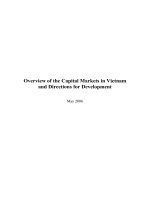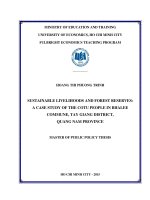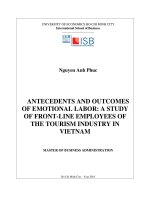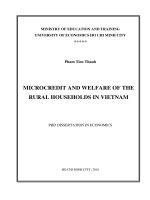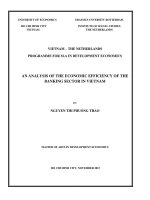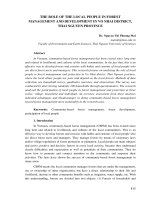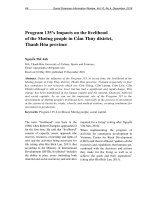PALM LEAF MANUSCRIPTS OF THE CHAM PEOPLE IN VIETNAM - Full 10 điểm
Bạn đang xem bản rút gọn của tài liệu. Xem và tải ngay bản đầy đủ của tài liệu tại đây (437.33 KB, 16 trang )
Studies on Asia Series V, Vol. 1, No. 1 (Spring 2016)
Research Notes
Palm Leaf Manuscripts of the Cham People in Vietnam*
Truong Van Mon
University of Social Sciences and Humanities
Vietnam National University at Ho Chi Minh City
The records of the Champa civilization, which was located in central
Vietnam, go as far back as the second century (192). The Cham were
profoundly influenced by Indian civilization and Islam. Although Champa
culture remained vibrant until around 1832, much was lost throughout
periods of assimilation of ethnic minority communities into Vietnamese
society. In particular, warfare with the Vietnamese and the Khmer from
the tenth to the nineteenth century left Champa polities on the brink of
collapse.1 Currently, there are only an estimated 161,700 Cham people
remaining in various provinces and cities in Vietnam. The largest
population centers are concentrated in Ninh Thuan, Binh Thuan, An
Giang, and Tay Ninh provinces, as well as Ho Chi Minh City.2 The
contemporary Cham retain some aspects of Champa culture. They still
venerate Champa temples, create Champa styled statues, and study
Champa inscriptions. In particular they still value palm leaf manuscripts
(agal bac) which are kept and used by Hindu influenced Cham priests
(Ahiér) for their religious rituals.
*
The author acknowledges that this research was funded by the Vietnam National
Foundation for Science and Technology Development (Grant Number IV1.3-2013.04).
The editor would like to thank William B. Noseworthy at the University of Wisconsin,
Madison, for his assistance with editorial feedback and Vietnamese-English translation.
1
For further information on the history of the Cham, see Po Dharma, Le Pāṇḍuraṅga
(Campā), 1802-1835 : ses rapports avec le Vietnam, Vol. 1 and Vol. 2 (Paris: ẫcole
franỗaise d'Extrờme-Orient, 1987).
2
The General Statistics Office of Vietnam, 2009.
122
Studies on Asia Series V, Vol. 1, No. 1 (Spring 2016)
In recent years an increasing number of studies on the Champa and
Cham culture have been conducted, resulting in more than 2,300 books
and journal articles.3 These studies were mostly based on ethnographic
fieldwork, philological examination of inscriptions, or historical
documents from China and Vietnam, with little attention to agal bac.
Centuries old and produced by the Cham themselves, agal bac are some of
the most crucial primary sources for scholarly study of the Cham culture.
This research note will explain the key features of palm leaf manuscript
heritage to facilitate and promote further in-depth analysis of the historical
and contemporary Cham culture.
Production of the Palm Leaf Documents
South Asian cultures have long used dried palm leaf as writing
material for their religious texts; the Tamil, Telugu, and Hindi palm leaf
manuscripts appear as early as the 5th century B.C.E. Since they were
influenced by South Asian civilizations, Southeast Asian cultures,
including Javanese, Indonesian, Khmer, Thai, and the Cham, used palm
leaves in a similar way.4 In particular, the Cham preserved the hala kadrap
form of palm leaf manuscript which the Ahiér Cham priests still use today.
Hala kadrap, or Corypha lecomtei Becc, is a tree that belongs to
the Areca family (Arecaceae). Although the tree can be found across
South and Southeast Asia today, in Vietnam its range is limited to the
central region’s forested areas of Dai Lanh, Quang Nam province as well
3
P. B. LaFont, Po Dharma, and Nara Vija, Catalogue des Manuscrits cam des
Bibliothốques Franỗaises. Vol. 114 (Paris: ẫcole Franỗaise d'Extrờme-Orient, 1977);
Nguyn Hu Thụng, Tng th mc Champa [Total of Champa bibliographic catalogue]
(Hà Nội: Nxb Thuận Hóa, 2003).
4
For a summary on some basic research concerning palm leaf manuscripts, especially
liturgical writings on palm leaves (agal bac) and “normal” palm leaf (hala hala kadrap or
lipuel) of the Cham people, see Sakaya, Từ điển Chăm-Việt-Anh; Việt-Chăm-Anh [ChamVietnamese-English dictionary; Vietnamese -English-Cham dictionary] (Hà Nội: Nxb Tri
thức, 2014), 331-532.
123
Studies on Asia Series V, Vol. 1, No. 1 (Spring 2016)
as Tanh Linh and Can Cu 4 in Binh Thuan province.5 Mature specimens of
this tree can stretch well over a meter in height with a trunk 40 to 60
centimeters in diameter. The leaves are large, with petioles at least 8
centimeters in length. Having deep grooves, the leaves can be up to 30
centimeters in width at the base of the tree. The edges are colored, often in
black, and individual leaf blades are up to 4.5 meter long. There are fifty
blade segments to a leaf, with 250 centimeters long passages between
them. The light green body of the palm is at least 2.5 meter long with few
branches. The stem usually branches several times. The older leaves are
drier and water resistant. They are thus used to make palettes for simple
walls in a house or hut. However, the young leaves of this tree, which can
be also woven together to make bags, mats, or sails, were historically used
as writing materials.
The production of palm leaf manuscripts is an art that, up until
recently, had been lost for over five generations in Cham communities.
Mr. Quang So, a fifty four year-old Ahiér Cham priest in Ninh Thuan
stated the following regarding palm leaf collection and manuscript
production:
My father, who used to be a priest at Po Klaong Girai
towers in Ninh Thuan, once said that there were many
different kinds of palm trees growing in the mountains.
The thin type of palm leaves was collected to make roof
material or boxes. The thick type of palm tree leaves had
no veins, and thus was used to record religious texts. This
latter type of palm trees grew plentiful in the mountain
areas of Tanh Linh district in Binh Thuan province. In
preparation to produce the palm leaf religious documents,
the Cham harvested the appropriate leaves from the
5
Dai Lanh is located near Da Nang City. For further information on palm leaf, see the
resource pages at />
124
Studies on Asia Series V, Vol. 1, No. 1 (Spring 2016)
mountains or bought them from Raglai.6 They then
typically chose the young and tender leaves which then
got dried to avoid book worms prior to the priests’
inscription of religious verses onto the surface of the
leaves. The Cham usually gathered the palm leaves in the
dry season around the fourth month of the Cham calendar
(from June to July in the solar calendar).
According to Mr. Quang So, once the leaves were prepared, the
following steps were taken to produce the manuscripts:
The priest used a steel penknife to engrave letters on the
leaves. Once the priest was finished engraving the leaf, a
pulverized charcoal powder-based black ink was applied
character by character. The black charcoal ink appeared
very clearly on the surface of the leaves. Desiring to write
the religious verses on palm leaves is a good practice.
Cham must make this into a habit. The majority of former
Po Adhia7 priests frequently wrote and copied texts on
palm leaves. However, the art of inscribing the palm
leaves was lost more than five generations ago. Current
Cham priests inherited their palm leaf manuscripts from
their forefathers. They use them during ceremonies in
temples and other customary occasions for the Ahiér
Cham in the area. However, no one knows how to
inscribe letters on the palm leaves any longer.8
As described above, Cham priests in Vietnam today have heard about the
production of agal bac from older generations, but have no knowledge of
how to produce palm leaf manuscripts themselves.
6
The Raglai are another Austronesian ‘Chamic’ ethno-linguistic community in south
central Vietnam. ‘Chamic’ peoples of Vietnam include: the Jarai, Rhade, Churu, Raglai
and Cham.
7
The Po Adhia are the senior priests of the Ahiér Cham.
8
Ethnographic fieldwork data, Mr. Sakaya’s interview with Mr. Quang So in Hieu Le
village, Ninh Phuoc district, Ninh Thuan province on February 20, 2014.
125
Studies on Asia Series V, Vol. 1, No. 1 (Spring 2016)
In an effort to restore, preserve, and promote the cultural values
behind the tradition of palm leaf manuscript production in the Cham
community, Dr. Shine Toshihiko (Kyoto University, Japan) and the author
traveled to Bali, Indonesia to meet the contemporary Balinese masters in
palm leaf writing. The Balinese were also influenced by Indian
civilization, and their culture is one of the most similar cultures to the
Cham in Southeast Asia.9 Upon arriving in Bali on December 3, 2013, the
team learned how to write letters on the palm leaves. Balinese informants
said that from April to May each year they usually go up to the mountain
and gather palm leaves. Then, after drying them, they use a sharp steel pen
to inscribe the letters on the surface of the leaf. When the writing is done,
they apply black ink that was made out of powdered charcoal on each
page of the leaves.10
After returning to Vietnam to study the palm leaf manuscript
production of the Cham in April 2013, the team concluded that the
typeface, method of writing, and the ink on the palm leaf surface of the
Cham were very similar to those of the Balinese people. Since then, the
author visited the Cham communities throughout Ninh Thuan and Binh
Thuan provinces in Vietnam to find Cham priests who were interested in
restoring the tradition of palm leaf manuscript production among the
Cham people. Finally, Basaih Nai Cao Liem, a forty-two year old Cham
priest in Ninh Thuan, was able to locate palm leaves that could be used as
samples for manuscript production. Mr. Nai Cao Liem then took a trip to
Tanh Linh district in Binh Thuan province to gather palm leaves.
For manuscript production, palm leaves must be young and soft
with no veins on the surface. Before writing letters on them, the leaves
have traditionally been dried in the sun for two days before they were cut
into pieces either 20-30 centimeters long and 4-5 centimeters wide, or 309
On Balinese culture, see Miguel Covarrubias, Island of Bali (Hong Kong: Periplus,
1937); Fred B. Eiseman, Jr., Bali: Sekala & Niskala (Tokyo and Rutland: Tuttle, 1990).
10
Trương Văn Món and Shine Toshihiko, "Vấn đề nghiên cứu và bảo tồn văn bản lá
buông của người Bali - Indonesia và người Chăm ở Việt Nam" [Research and
conservation: problems of palm leaf manuscripts of the Balinese in Indonesia and the
Chams in Vietnam], Tạp chí Nghiên cứu Văn hố Chăm 2 (2013): 106-109.
126
Studies on Asia Series V, Vol. 1, No. 1 (Spring 2016)
50 cm long and 5-8cm wide, depending on individual preference and the
size of the leaves. Afterward, the palm leaves were dipped in water and
then pressed by placing heavy objects on them for 2-3 days. After going
through this process, the surface of the leaves became flat as paper. Then a
sharp steel pen and powdered charcoal were used to inscribe letters on the
palm leaves.
Preservation of the Palm Leaf Manuscripts
There is only a small portion of the old agal bac that are preserved
in the Cham community today. There are approximately 150 manuscripts
totaling 10,000 leaves that Ahiér Cham priests (predominantly of the Po
Adhia or Po Tapah classes) have kept in Binh Thuan and Ninh Thuan
provinces. These manuscripts cover a range of topics, but the majority are
for use in temple rituals. Each set of the old palm leaves has inscriptions
from 5-7 individual prayer texts that have been passed down from one Po
Adhia to another. In addition to these agal bac that were kept within the
Cham community, a small number of palm leaf manuscripts were stolen
during the wars with Dai Viet. They have been kept by the Vietnamese in
Da Nang and Binh Dinh provinces. We collected four of these stolen
manuscript sets, totaling about 300 leaves, during our field research in
recent years.
A small number of palm leaf manuscripts are preserved in personal
collections, museums, and international research institutes. Prior to 1975,
Gerard Moussay collected more than twenty from Phan Ri in Binh Thuan
province. These are preserved in the Cham Cultural Center in Phan Rang,
Ninh Thuan province. Since the reunification of Vietnam in 1975, over
twenty sets of the texts, totaling a thousand leaves, have been kept in the
Cham Cultural Centers and Museums in Ninh Thuan and Binh Thuan
provinces, aside from those that were lost during the wars. In the United
States, the Jay Scarborough collection in the Cornell University library has
one palm leaf manuscript of thirty-pages in microfilm/microfiche form.
While some paper manuscripts and rubbings of inscriptions are found in
the archives of the ẫcole franỗaise d'Extrờme-Orient (French School of
Asian Studies), no agal bac is included in the EFEO collections.
127
Studies on Asia Series V, Vol. 1, No. 1 (Spring 2016)
During the last two decades or so, the author and a team of
collaborators have located and catalogued approximately 150 palm leaf
manuscripts, totaling 10,000 leaves. We have scanned and photographed
these precious artefacts of Cham culture in an attempt to preserve them for
future generations. Despite the importance of these materials, the agal bac
have not received much attention from researchers, collectors, or state
authorities until recently. The next step of our project is to publish
Vietnamese-English analyses and selected translations of the Cham agal
bac.
The Form and Language of Palm Leaf Manuscripts
Agal bac come in many different sizes. The smallest are 20-30
centimeters long and 4-5 centimeters wide, although they can be as large
as 50 x 15 centimeters. Many are in the range of 30-50 centimeters x 5-8
centimeters. Each agal bac set has 13 to 180 double-sided leaves, and
they are frequently encased in bamboo or wooden covers. Cover materials
are usually sleek, dark reddish brown in color, and often intricately carved.
Holes for thread or vine allow the pages to be attached together with two
cover pages.
The script of most agal bac manuscripts is Akhar Thrah. Akhar
Thrah is a type of standard script used by the Cham today that emerged in
the early modern period in its earliest form. It is a member of the PallavaGrantha sub-family of the Brahmi scripts. Earlier versions of Cham
scripts, known as Akhar Hayap or Akhar Bitau in Cham, were used to
carve epigraphic inscriptions on stones and towers, whose ruins can be
found throughout central Vietnam. However, the orthography of Akhar
Thrah is quite different from the epigraphic scripts. The first known
appearance of Akhar Thrah is an inscription on the Po Romé tower that is
dated to the seventeenth century. Therefore, based on the orthography of
the palm leaf manuscripts, we can hypothesize that they date to the
seventeenth century and later. This does not mean that palm leaves were
not used earlier with a different orthography. If they were, however, none
of these earlier manuscripts survived. A second feature of the manuscripts
that is useful in dating their content is the appearance of a mixture of
128
Studies on Asia Series V, Vol. 1, No. 1 (Spring 2016)
Sanskrit, Arabic, Cham, and Malay vocabulary. While Sanskrit, Cham,
and Arabic vocabulary can all be dated in their earliest appearance in the
region to the 4th, 7th, and 12th centuries, respectively, Malay vocabulary
did not become popular among Cham priests until the 15th century and
later. The confluence of varied linguistic influences means that individuals
who can read their content fluently are few and far between, even in the
Ahiér priesthood.
[Photo 1] Agal bac from the Cham in Vietnam (NVV, March 3, 2013).
Agal bac Research Methods
Studying palm leaf manuscripts requires a set of specific research
skills. First, researchers need to be equipped with not only fluency in the
Cham language but also a solid knowledge of several other relevant
languages. For this reason, a team of researchers with language skills in
Malay, Sanskrit, and Arabic is necessary. Secondly, studying agal bac
requires ethnographic fieldwork research training to interview the Cham
priests, to learn about proper use of the manuscripts, and to engage with
readings of the manuscripts. In addition, skilled archivists to collect, scan,
and photograph the manuscripts are necessary. Finally, skills to catalogue
and transliterate Cham language texts into Vietnamese and other
129
Studies on Asia Series V, Vol. 1, No. 1 (Spring 2016)
languages, such as Malay, French, Japanese, or English, are needed in
order to make the materials accessible for academic and public educational
purposes. An in-depth understanding of Cham culture is indispensable as
well to provide the appropriate background knowledge and context to
ensure an accurate translation of the manuscript. Overall, these sets of
research skills will be critical to cross check information gathered through
interviews and the textual analysis on each agal bac manuscript.
The Content of Agal bac
The agal bac manuscripts cover many different topics. The subject
matter concerns religious rituals, outlooks on life, paradigmatic
expressions, calendars, and directions for offerings for fields and
buildings, as well as imbibing talismans with spiritual potency.
For example, the agal bac manuscript that the author’s team
gained access to among the collections of a priest who managed the
temple towers in Phan Ri in Binh Thuan province deals with the subject of
“Aiek Tanah Riya” (The Sciences of Wind and Water). The manuscript
has seventy-four leaves, and the English translation of the first part of the
second leaf begins:
[The God of the Seas and Rivers] said that the land that is high in
the east and low in the west is bad. If water is flowing from the
east to the west (on the land), this is bad. If the land that is high in
the north and is low in the south, this is bad. Water flowing in the
east is also bad.
While the document above reveals the auspicious directions that are
associated with nature, another agal bac manuscript (GVH09) discusses
rituals for land worship while presenting a philosophical worldview. It
specifically mentions the eight directions including north, south, east,
west, northeast, southeast, northwest, and southwest. Since Cham culture,
unlike Hindu conceptions of geography, only includes four directions, east
(gah aia harei tagok), west (gah aia harei tamâ), south (gah mraong), and
north (gah birak) in that order, we can argue that this particular document
indicates the influence of Hindu culture on the indigenous Cham.
130
Studies on Asia Series V, Vol. 1, No. 1 (Spring 2016)
Another example of agal bac text that involves land purification
comes from the collection of Quang Du (GD02), a sixty-five-year-old
deputy priest of Po Ina Nagar Temple in Huu Duc village in Ninh Thuan
province. Totaling 111 leaves and titled “Tanah Balih” (Text to Purify
Lands, Towers, and Buildings), the English translation of the first leaf of
the manuscript reads:
On behalf of Siva-yang, I will perform this rite. I had just stepped
out of the house and saw the god-bird Garuda holding in its beak a
dragon that was flying into the sea. The dragon scales became a
golden parasol; and the saliva of the dragon became artesian waters
as they fell upon the land.
Similarly, the following agal bac documents (GD01, GN7) indicate the
way a land purification ceremony was performed:
In the name of Siva-yang, I will perform this rite. I walk out into
the yard, with my feet on the earth and head toward heaven, and
then see the Garuda bird (ina garit) carrying a dragon (inâ girai)
flying over the sea. The skin of dragon is stripped off to become a
golden parasol, and the dragon's saliva falls to the earth to become
the source of water for the rivers and the streams. The dragon's
bones fall into the earth and become the high mountains and thick
forests.
When worshipping at midnight, Cham priests hold ritual sticks (gai drâng)
as they move about to purify the land while reading these prayers.
The text above is from a manuscript set that has 111 leaves. The
first leaf of this manuscript contains the phrase “Ni suk tik dhik si si,”
which is a common expression to open Ahiér Cham prayers. It is spelled
in many variations in Cham and comes from the Sanskrit, “Ni swasti
sidhi.” Ni means “this,” and swasti “auspicious words.” Sidhi refers to
“occult powers” used to control the elements. Additionally, the names of
two supernatural animals appear repeatedly. Both animals were popular
historically across Southeast Asia. Symbolically, Garuda is derived from
Hindu culture. On the other hand, the dragon, in common Cham visions of
history, was originally a naga serpent in the times of Champa. However,
after the early modern period, artistic renditions of the inâ garai dragon
131
Studies on Asia Series V, Vol. 1, No. 1 (Spring 2016)
came to closely resemble similar Chinese and Vietnamese dragons (Vn.:
long). The text on Leaf 12 of the same agal bac manuscript reads:
The Snake-god eats everything. Please, Snake-god, release the
people, do not come to harass them again. If we see the white
dragon that dominates the border of the country, then we will
invite it to reign in the desert-sand. If the red dragon dominates the
middle part of our country, we would like to invite the red dragon
to reign halfway up the mountain (to avoid disaster for humans).
While the above manuscripts detail rituals outside the temple complexes,
other palm leaf manuscripts, such as agal bac GVHCNT 02 and 03, give
further details on their religious rituals at temple towers for Basaih priests.
These ceremonies include: the tower opening ritual (peh mbeng yang), the
sacrifice ritual for the fire god (yuer yang), Katé rituals, and the
worshiping ritual for the goddess (cambur). The manuscript gives very
clear guidelines concerning the ritual sacrifice to the fire god (yuer yang)
along with an explanation for each symbol in the ritual, including nandin
(holy cow), abaoh jap (stringing), adhaong halah (knife), pangin manyak
li-u (cup containing coconut oil for light), and bingu pak coh (Champa
flower).
In tower rituals, the sacrificial objects are often placed in a bamboo
basket, called baginrac, held by a Po Adhia priest. During this ritual, the
Po Adhia holds up objects moving his hands as if he is clapping, and then
draws magical designs on the face of the earth and in the air while
whispering prayers. Some previous ethnographers and cultural researchers
who studied Cham rituals did not take time to examine the agal bac texts,
especially since they had no access to them. However, the meanings and
symbols of the ritual objects that were mentioned in the palm leaf
manuscript can offer important explanations of some key aspects of Cham
culture. Only by reading the complete agal bac, can one understand all the
symbolism behind the sacrificial rituals at the Cham towers and also
analyze how they were connected to the Hindu culture of South Asia.
132
Studies on Asia Series V, Vol. 1, No. 1 (Spring 2016)
[Photo 2] The Basaih monks of the Cham Ahier read old agal bac
in a ceremony (Photo by the author, 2014).
Another interesting example of the agal bac manuscripts comes
from the Da Nang (GDN0, GDN 02, GDN03) and Binh Dinh (GBD01)
collections. These are also religious texts that were used during sacrificial
offerings at Cham towers. They are written in Akhar Thrah although the
vocabulary is influenced more heavily by Hindu Sanskrit than the Binh
Thuan and Ninh Thuan manuscripts. It is possible that these particular
manuscripts are crucial evidence that demonstrates that, although the
Cham in Da Nang recorded in epigraphic scripts, they also have written in
Akhar Thrah prior to the seventeenth century. However, it is also probable
that the Vietnamese captured these agal bac documents from the southern
Cham territories, such as Binh Thuan and Ninh Thuan, and brought them
to Da Nang and Binh Dinh trying to merge the power of the manuscripts
with the old Champa civilization sites. In the case of the latter, more likely
hypothesis, the manuscripts are evidence of historical Vietnamese
attempts to merge the spiritual potency of Cham manuscripts with territory
claimed through conquest.
In addition to the ritual details, agal bac documents can also reveal
details concerning the Cham calendar (sakawi) as in the case of the
133
Studies on Asia Series V, Vol. 1, No. 1 (Spring 2016)
manuscript GVHCNT 07. The text contains an original Cham calendar
which appears to be very accurate. If this calendar were to be translated
and published, it could help standardize the contemporary Cham calendar.
There is one contemporary calendar that is recognized for Ninh Thuan
province and one for Binh Thuan province, a fact which remains
controversial among Cham communities even today. A standardized
calendar would therefore be of great use to local communities.
Agal bac GTVHCNT 02 records astronomical events. It is a study
of the stars, lunar and solar eclipses, and signs of the weather. In
particular, this text addresses how astronomy influences the health of
humans, animals, plants, as well as harvests, wars, and the destiny of their
country and nation. Cham astronomers were very well respected and well
known through the colonial period, although their knowledge and fame
has become lost in contemporary society. Nevertheless, the records of
such astronomical texts still remain in the form of the agal bac
manuscripts.
Finally, manuscript GVHC11 contains text that deals with the
cycle of dragons. It rotates along with the direction of the earth affecting
the seas and the other bodies of water. The cycle also dictates good and
bad days for constructing towers and buildings, as well as good directions
for travel. This manuscript classifies the types of dragons in Cham culture,
such as the white dragons (inâ garai patih), yellow dragons (inâ garai
kanyik), red dragons (inâ garai mariah) and black dragons (inâ giarai
hitam). The manuscript then illustrates auspicious timing for building
houses, towers, and dams in the community. If this kind of agal bac text is
translated and published, it will clarify the ways in which “dragons” were
conceptualized within the Cham and broader Southeast Asian cultures.
This text also suggests that Cham dragons might be more than what was
simply derived from Chinese culture.
Conclusion
The popularity of the use of agal bac was not only among the
Cham people of Vietnam but also throughout the region of Southeast Asia.
As introduced above, the agal bac texts contain information on numerous
134
Studies on Asia Series V, Vol. 1, No. 1 (Spring 2016)
valuable topics and aspects of Cham culture. Further efforts to discover,
preserve, and analyze these palm leaf manuscripts will bring current
research and understanding of Cham culture to a higher level as these texts
reveal much about the Cham religion, calendar, astronomy, philosophy,
and festivities among other topics.11 Moreover, agal bac also points out
the relationship between the Cham and surrounding cultures such as
Indian, Malay, Arabic, Vietnamese, and Chinese.
Further Readings on Agal bac
Aymonier, Etienne. Dictionnaire Cam-Franỗais. Vol. 4. Paris: ẫcole
Franỗaise d'Extrờme-Orient, 1906.
-----. The History of Tchampa: The Cyamba of Marco Polo, Now Annam
or Cochin China.” Imperial and Asiatic Quarterly Review 4 (1893): 140148, 365-381.
-----. Les Tchames et Leurs Religions. Paris: Leroux, 1891.
-----. “Legendes Historiques des Chams.” Excursions et Reconnaissances
14, no. 32 (1890): 145-206.
-----. “Lettre de M. Aymonier au Gouverneur de la Cochinchine sur son
Voyage au Binh thuan.” Excursions et Reconnaissances 9, no.22 (1885):
247-254.
Cabaton, Antoine. "L’inscription Chame de Bien Hoa. Bulletin ẫcole
Franỗaise d'Extrờme-Orient 4 (1904): 687-690.
-----. Nouvelles Recherches sur les Chams. Paris: ẫcole Franỗaise
d'Extrờme-Orient, 1901.
11
Editors note: According to Mr. Hao Phan, Southeast Asia Curator at the Northern
Illinois University Library, a preservation project of the Cham documents, funded by the
British Library, digitized more than five hundred Cham manuscripts which are available
online at the following link: />
135
Studies on Asia Series V, Vol. 1, No. 1 (Spring 2016)
The Center for South and Southeast Asia Studies (Berkeley, California),
ed. Le Campa et Le Monde Malais. Paris: Centre d'Histoire et
Civilizations de la Peninsule Indochinoise, 1991.
Covarrubias, Miguel. Island of Bali. Hong Kong: Periplus, 1937.
Đặng Nghiêm Vạn (Chủ biên). Dân tộc học đại cương. Hà Nội: Nxb Giáo
dục, 2000.
Dharma, Po. Le Pāṇḍuraṅga (Campā), 1802-1835: ses rapports avec le
Vietnam. Vol. 1 and 2. Paris: ẫcole franỗaise d'Extrờme-Orient, 1987.
Eiseman, Fred B. Jr. Bali: Sekala & Niskala. Tokyo and Rutland: Tuttle,
1990.
Golzio, Karl-Heinz, ed. Inscriptions of Campa. Aachen: Shaker Verlag,
2004.
Gusti Made Sutjaja, I. Satua Bali: Tales from Bali. Denpasar: LotusWidya Suari, 2005.
Gusti Made Widia, I. Kakawin of Ramayana, Song of Adventure: KawiInggeris-Indonesia. Singaraja: Indra Jaya, 2007.
Hefner, Robert W. Hindu Javanese: Tengger Traditional and Islam.
Princeton: Princeton University Press, 1989.
Hooykaas, Christiaan. A Balinese Temple Festival. Hague: Martinus
Nijhoff, 1977.
Jacques, Claude. ẫtudes ẫpigraphiques sur le pays Cham. Paris: ẫcole
Franỗaise d'Extrờme-Orient, 1995
LaFont, P.B. Le Champa: Géographie-Population-Histoire. Paris: Les
Indes Savantes, 2007.
----- and Po Dharma. Bibliographie Campa et Cam. Paris: ẫcole Franỗaise
d'Extrờme-Orient, 1989.
136
Studies on Asia Series V, Vol. 1, No. 1 (Spring 2016)
-----, Po Dharma, and Nara Vija. Catalogue des Manuscrits cam des
Bibliothốques Franỗaises. Vol. 114. Paris: ẫcole Franỗaise d'ExtrờmeOrient, 1977.
Maspero, Georges. Le Royaume de Champa. Paris: Van Oest, 1928.
Majumdar, Ramesh C. Champa: History and Culture of an Indian
Colonial Kingdom in the Far East 2nd-16 th Century A.D. New Delhi: Gian
Publishing House, 1985.
-----. Ancient Indian Colonies in the Far East. Vol.1. Delhi: Greater India
Society Public, 1985.
Phần, Thành. Danh mục thư tịch Chăm ở Việt Nam. Hồ Chí Minh: Nxb
Trẻ, 2007.
Sakaya. Từ điển Chăm-Việt- Anh; Việt - Chăm- Anh. Hà Nội: Nxb Tri
thức, 2014.
-----. Tiếp cận một số vấn đề về văn hoá Champ. Hà Nội: Nxb Tri thức,
2012.
Thông, Nguyễn Hữu. Tổng thư mục Champa. Hà Nội: Nxb Thuận Hóa,
2003.
Văn Món, Trương and Shine Toshihiko."Vấn đề nghiên cứu và bảo tồn
văn bản lá buông của người Bali - Indonesia và người Chăm ở Việt Nam."
Tạp chí Nghiên cứu Văn hố Chăm 2 (2013): 106-109.
Wong Tze- Ken, Danny. Champaka Monograph 5: The Nguyen and the
Champa During 17th and 18th Century: a Study of Nguyen Foreign
Relations. Paris: International Office of Champa, 2007.
137
